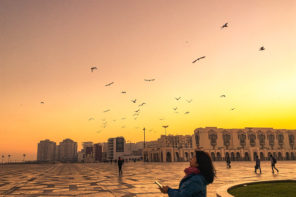Time to look at girls: migrants in Bangladesh and Ethiopia. Documentary film. 2015.
Produced and researched by: Katarzyna Grabska, Nicoletta Del Franco, and Marina de Regt
Directed by: Marco Speroni, 31 min
Based on research funded by the Swiss Network of International Studies, Girl Effect Ethiopia, Terre des Hommes Federation, University of Sussex, UK and the Feminist Review Trust
The increasing number of girls who move to cities is a momentous global change. Why are adolescent girls migrating and what happens to them? How are their families and close ones affected? What are the constraints and opportunities linked to migration for adolescent girls?
Bangladesh and Ethiopia are two examples of countries where girls’ independent migration is on the rise. This film explores the circumstances, decision-making, experiences and consequences of migration for adolescent girls in Bangladesh and Ethiopia. It is based on a research project “Time to look at girls: adolescent girls’ migration and development” (January 2014–December 2015), that explores the links between migration of adolescent girls and economic, social and political factors that trigger their movements. It shows the agency and choices being made by adolescent girls in their diverse migration experiences.
More migrants move within their own country or region than migrate to Northern countries. Bangladesh and Ethiopia have been experiencing increasing high rates of the migration of adolescent girls to work. In Bangladesh they are found for example in garment and other manufacturing industries; working as maids; or in beauty parlours. In Ethiopia, migrant girls are mainly escaping early marriages, seeking better living conditions, or aspiring to continue their education. Most of them take up paid work as maids or sex workers.
The film is based on four parallel stories about the trajectories of migration of adolescent girls in Bangladesh and in Ethiopia. In Bangladesh, the film portrays Lota and Sharmeen who are employed in garment factories. In Ethiopia, the documentary follows the lives of Tigist and Helen, two internal migrant girls, who end up in sex work. This beautifully shot film provides space for the powerful voices of the migrant girls who speak about their own circumstances, experiences, dreams for the future.
Breaking away from the dominant focus on girls as victims of trafficking, this film gives evidence of the resilience, creativity and agency of young migrants girls who faced with difficult choices.
Screenings dates
- LOVA summer school: VU University Amsterdam, August 2015.
- Time to look at girls: project closing workshop: Addis Ababa, 20 October 2015 – 35 people attended, with after film discussion with two Ethiopian protagonists.
- French Centre of Ethiopian Studies, Addis Ababa, 20 October 2015 – 22 people attended, with after film discussion with two Ethiopian protagonists.
- NIKAT – charitable organisation of sex-workers in Addis Ababa, 21 October 2015 – 15 people attended, the majority sex workers (many girl migrants) with after film discussion with one of the Ethiopian protagonists.
- Afhad University for Women, Omdurman, Sudan, The Regional Institute of Rights, Gender, and Peace: 22 October 2015 – 15 master students and 2 professors attended the screening.
- Institute of Social Studies, the Hague, Holland, 26 October 2015.
- French Research Centre, CEDEJ, Khartoum, Sudan, 14 November 2015.
- Conference on the Migration in the Horn of Africa, CEDEJ, Khartoum, Sudan, 18 November 2015
- VU University Amsterdam, 3 December 2015.
- Bangladesh, Dhaka, 30 November 2015 – Terre des Hommes: launch of the report and the screening of the film.
- Warsaw, 22 December 2015.
- London, Brighton, March week of 14th, 2016.
- Geneva, IHEID, June 2016.








